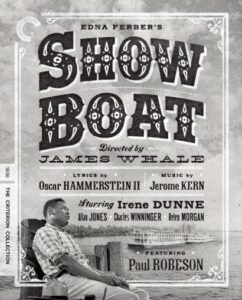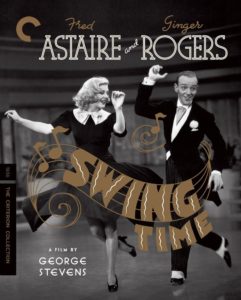March 2024
Gary is one of the many former Village Voice writers interviewed for the new book The Freaks Came Out to Write, by Tricia Romano.
November 2023
Gary is interviewed on the February Blu-ray release of Raoul Walsh’s The Roaring Twenties – preorder it now!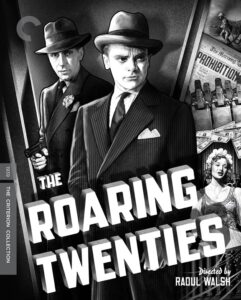
July 2023
Gary discussed the beginnings of jazz, vaudeville, minstrelsy, blues, spirituals and his book Visions of Jazz on the Let It Roll Podcast.
April 2023
Gary contributes to the 2023 documentary Reed Rapture in Brooklyn (soon debuting at local film festivals), based on a unique 12-CD set of reed duets organized by saxophonist Ivo Perelman.
January 2023
The Criterion Collection has announced its April Blu-ray releases, which includes a 4K restoration of Bergman’s The Seventh Seal, with an essay by Gary.
December 2022
CUNY host Jerry Carlson recently interviewed Gary about the film One-Eyed Jacks.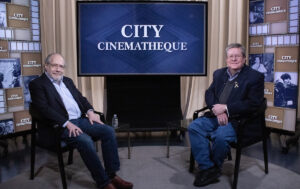
An updated list for 2022 of the top ten Criterion Collection discs includes “Anatomy of a Murder” with an interview with Gary discussing Duke Ellington’s score.
Gary’s Riding on a Blue Note: Jazz and American Pop has again landed on a best jazz books list for year end.
Biographer Aidan Levy, whose latest biography is Saxophone Colosus: The Life and Music of Sonny Rollins, says Gary played a pivotal role in crafting the book.
November 2022
An interview in the NY Times with the great Mel Brooks features mentions of parts 1 and 2 of Gary’s Bing Crosby bio:
January 2022
The Criterion Collection releases a new 4K restoration of director Bertrand Tavernier’s ‘Round Midnight in April, featuring a new commentary by Gary. It’s been called “a love letter…to the heyday of bebop and to the Black American musicians who found refuge in the smoky underground jazz clubs of 1950s Paris.”
February 2021
Gary remembers the great Stanley Crouch.
October 2020
Gary returns for a follow-up chat on the Let It Roll Podcast to discuss Bing Crosby: Swinging on a Star – The War Years 1940-1946.
August 2020
The New York Times and columnist Alan Scherstuhl share Charlie Parker at 100: What to Read, Watch and Dig.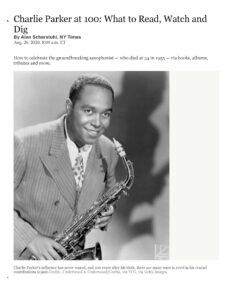
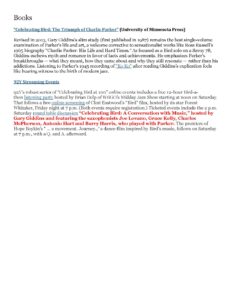
The Criterion Collection – UK releases a new blu-ray restoration of Anatomy of a Murder with an exploration of Duke Ellington’s score by Gary.
July 2020
Gary contributes to British director Jeremy Marre’s final documentary Count Basie: Through His Own Eyes, due out in October.
March 2020
Jeanine Basinger of the Wall St Journal lists Bing Crosby: A Pocketful of Dreams – The Early Years 1903-1940 “Five Best Books on Stars of Movie Musicals”

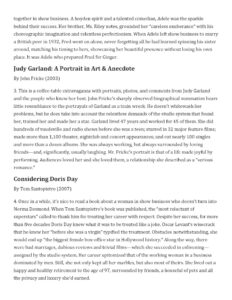

The Let It Roll podcast featured Gary and a discussion of both Bing Crosby: A Pocketful of Dreams – The Early Years 1903-1940 and Bing Crosby: Swinging on a Star – The War Years 1940-1946.
December 2019
Marcus Smith of BYU Radio’s program “Constant Wonder” chooses the holiday season to discuss Bing Crosby: Swinging on a Star – The War Years 1940-1946 with Gary.
Gary contributes an essay to the The Criterion Collection‘s March 2020 remastered Blu-ray release of the 1936 version of Jerome Kern/Oscar Hammerstein II’s magnificent Show Boat.
November 2019
Gary spoke at the Parkway Central Library in Philadelphia in December 2018 – there is video of his presentation on Bing Crosby: Swinging on a Star – The War Years 1940-1946.
October 2019
Gary provides audio commentary on a new blu-ray release of the 1945 Bing Crosby/Ingrid Bergman classic “The Bells of St Mary’s”, available now for pre-order.
Bing Crosby: Swinging on a Star – The War Years 1940-1946 has been awarded the 2019 Association for Recorded Sound Collections‘ Award for Excellence in Historical Recorded Sound Research – History Book of the Year.
Holly-George Warren of Publishers Weekly still finds Gary’s first Bing bio, Bing Crosby: A Pocketful of Dreams – The Early Years 1903-1940 among “Ten Essential Music Biographies” – she’s got the second Bing bio in her stack of books yet to read.
August 2019
Dick Dinman’s DVD Classics Corner, featured on TCM.com, hosts an interview with Gary about the recent blu-ray release of Swing Time and Bing Crosby: Swinging on a Star – the War Years 1940-1946.
Jazz Profiles features an updated “People Time” essay on Stan Getz.
Turner Classic Movies has featured Bing Crosby: Swinging on a Star – The War Years 1940-1946 on its home page book section and at the TCM Shop.
April 2019
The Jazz Journalists Association has nominated Bing Crosby: Swinging on a Star – The War Years 1940-1946 for “Jazz Book of the Year”.
March 2019
The Times Literary Supplement puts its stamp of approval on Bing Crosby: Swinging on a Star – The War Years 1940-1946. (Click on images to read)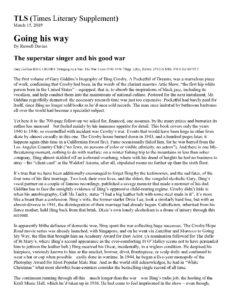
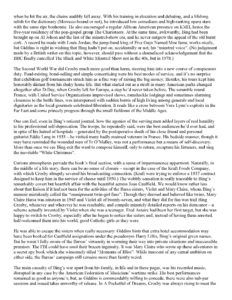

Levi Stahl of The Seattle Review of Books says that SWINGING ON A STAR – THE WAR YEARS 1940-1946 is “compelling reading”.
The Criterion Collection has announced a June blu-ray release of Swing Time, with an additional program, “In Full Swing”, with commentary by Gary.
TV critic John Anderson reviews Bing Crosby: Swinging on a Star – The War Years 1940-1946 in America: The Jesuit Review.
February 2019
Ira Gitler, RIP (NY Times)
Ira Gitler, RIP (Washington Post)
Film essayist David Bordwell has high praise for SWINGING ON A STAR – THE WAR YEARS 1940-1946 (scroll down a bit for “Bing & Bob’) – he also links back to another review he’s done on Gary’s work.
The Criterion Collection released another in their fine series of remastered Blu-Ray Leo McCarey productions, The Awful Truth, featuring commentary by Gary Giddins.
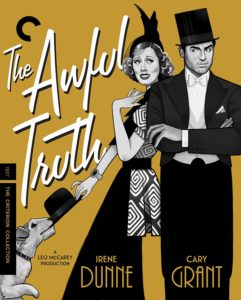
January 2019
Peter Tonguette of The National Review says “Crosby was no more flawed than many people, but possessed strengths more marked than most” in his review of Bing Crosby: Swinging on a Star – the War Years 1940-1946.
KSCO Santa Cruz radio host Gary Shapiro interviews Gary for From the Bookshelf (note: does not work with Google Chrome).
Upstate New York’s Syncopated Times says that Bing Crosby: Swinging on a Star – the War Years 1940-1946 is “…difficult to put down, often reading like a novel…this book seems too short and ends too soon.”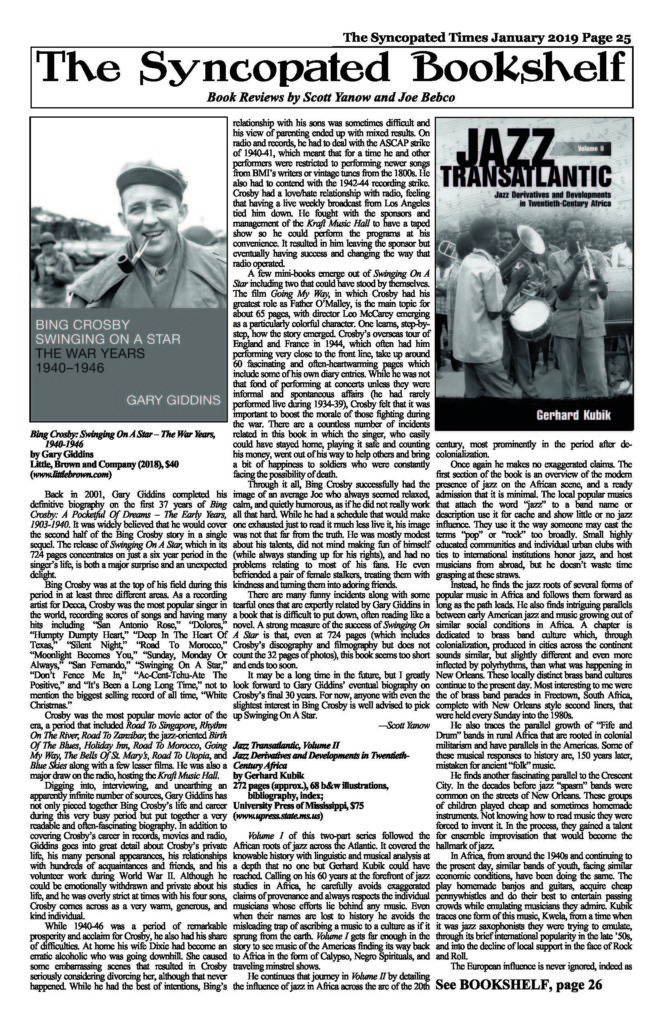
December 2018
The EWTN Network interviewed Gary about Bing Crosby: Swinging on a Star – the War Years 1940-1946 and Bing’s influence on vocations to the Roman Catholic priesthood.
The Arkansas Democrat Gazette shares a list of recommended books from 2018, among them Bing Crosby: Swinging on a Star – the War Years 1940-1946.
Princeton’s Town Topics and Stuart Mitchner’s “The Voice of America: Gary Giddins on the ‘Living Folklore’ of Bing Crosby.”
Buffalo News critic Jeff Simon says that Gary “… has done in two volumes now has been to create two-thirds of one of the greatest American showbiz biographies” in Bing Crosby: Swinging on a Star – the War Years 1940-1946.
City Pages-Minneapolis lists the Year in Music Books, which includes Bing Crosby: Swinging on a Star – the War Years 1940-1946.
Minnesota Public Radio’s “Rock & Roll Book Club”says that rock stars are still taking pages from Bing Crosby’s book today – from Jay Gabler.
Closer Weekly shares their interview with Gary about Bing Crosby: Swinging on a Star – the War Years 1940-1946 in their magazine this month.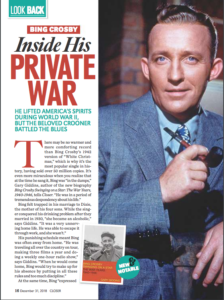
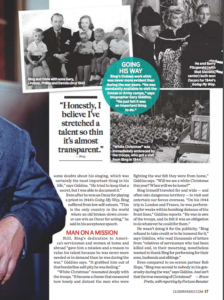
Gary Giddins on Bing Crosby and Swinging on a Star – a conversation with Ted Panken.
Gary, along with Kai Bird and Geoffrey C. Ward, discuss Bing Crosby: Swinging on a Star – the War Years 1940-1946 at CUNY Graduate Center on November 13, now on video.
Gary’s presentation in Philadelphia on December 4 is available on video.
Gary is interviewed on NPR’s All Things Considered.
The Pittsburgh Post-Gazette’s Rich Kienzle notes the complex, nuanced picture of a man in Bing Crosby: Swinging on a Star – the War Years 1946-1946.
Bing shared a few ‘favorites’ lists in his day, and the Wall Street Journal discusses them, along with Bing Crosby: Swinging on a Star – the War Years 1940-1946.
“Friend of Spokane” Gary Giddins and Bing Crosby: Swinging on a Star – the War Years 1940-1946, is at the top of the gift list in Spokane’s weekly newspaper, The Inlander.
Bing Crosby: Swinging on a Star – the War Years 1940-1946 is one of the Best Arts & Entertainment Books of 2018 according to Kirkus Reviews.
The Dallas Morning News is happy to review Bing Crosby: Swinging on a Star – the War Years 1940-1946.
Publishers Weekly lists Bing Crosby: Swinging on a Star – the War Years 1940-1946 as one of the Ten Best Biographies of 2018.
The Biographer’s Craft features an article (3rd down) about the November 13 CUNY Graduate Center Leon Levy Biography Center discussion about Bing Crosby: Swinging on a Star – the War Years 1940-1946.
One of 11 New Books Recommended by the NY Times – Bing Crosby: Swinging on a Star – the War Years 1940-1946.
Catholic News Service adds its praise for Bing Crosby: Swinging on a Star – The War Years 1940-1946.
Jazz Times reviews Bing Crosby: Swinging on a Star – The War Years 1940-1946.
Ten Things in the World to be Thankful For in 2018 – lucky #7 is Bing Crosby: Swinging on a Star – The War Years 1940-1946 from Foreign Policy Magazine.
For the jazz lover on your holiday gift list from from WBGO-FM in NYC – Bing Crosby: Swinging on a Star – The War Years 1940-1946.
November 2018
A Churchillian Sweep Of Crosby’s Life – Downbeat Magazine and John McDonough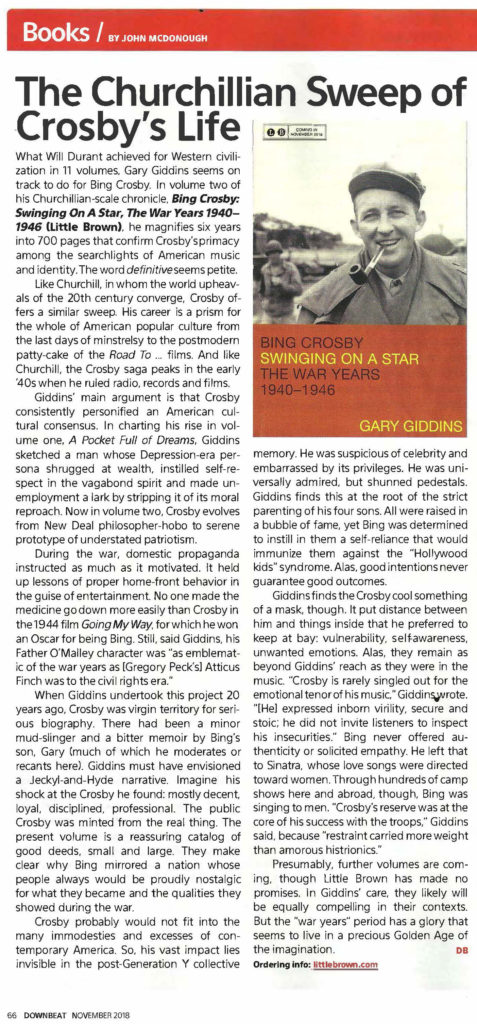
Bing Crosby: Swinging on a Star – The War Years 1940-1946 is reviewed in the Wall Street Journal.
A starred review for Bing Crosby: Swinging on a Star – The War Years 1940-1946 from Booklist.
October 2018
The Washington Post has a review of Bing Crosby: Swinging on a Star – The War Years 1940-1946.
What to read this week from Newsday – Bing Crosby: Swinging on a Star – The War Years 1940-1946.
Jazz Profiles gives their take on Bing Crosby: Swinging on a Star – The War Years 1940-1946.
Gary is interviewed by Jerry Jazz Musician founder and publisher Joe Maita about Bing Crosby: Swinging on a Star – The War Years 1940-1946.
Spokane’s daily newspaper, The Spokesman Review, interviews Gary about Bing Crosby: Swinging on a Star – The War Years 1940-1946.
The Spokane weekly newspaper, The Inlander, interviews Gary prior to his visit to Bing’s hometown.
A blu-ray release of My Man Godfrey features commentary by Gary.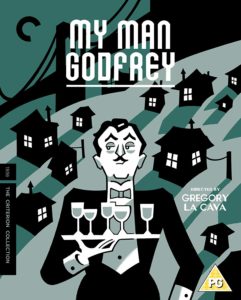
Fire Music film on free jazz features commentary by Gary.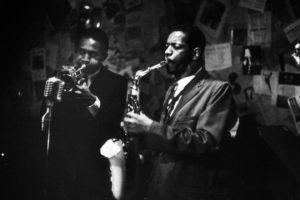
September 2018
A starred review for Bing Crosby: Swinging on a Star – The War Years 1940-1946 from Kirkus Reviews.
August 2018
A starred review for Bing Crosby: Swinging on a Star – The War Years 1940-1946 from Publishers Weekly.
July 2018
Gary has contributed an essay to the booklet accompanying this new DVD set from The Criterion Collection on the films of Marlene Dietrich.
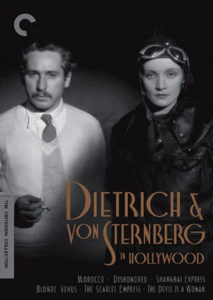
March 2018
Gary’s been interviewed (and provides a commentary track as well) in the newly remastered, newly released 1930 “King of Jazz” from The Criterion Collection. It’s Bing’s first on-screen performance, and our friend Leonard Maltin has penned a terrific review – check it out here (and be sure to order a copy!)
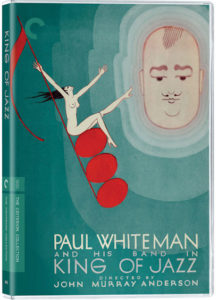
From Jazz Times, Nov 2006
Ornette!!!!
In Thomas Mann’s Buddenbrooks, the upstanding dandy Thomas Buddenbrook dismisses his wife’s elitist devotion to music as a “rather tasteless snobbery.” Gerda remonstrates that the insipid pop ditties Thomas prefers merely requite a need for mindless gratification. No fool, he is reduced to silence, unable to “comprehend why melodies that cheered him up or moved him were cheap and worthless, or why music that seemed harsh or chaotic should be of the highest musical value.”
Mann was writing in 1900, when the Schoenberg scandal was just getting started and Buddy Bolden had yet to organize his first band. But, of course, nothing has changed. It is no fun to face the disbelief of friends, family and students when arguing the virtues of sounds that scrape against their nerves like jagged razors. Almost every jazz lover has had to confront that kind of incomprehension, whether defending against accusations of polyphonic chaos, swing-era compromise, bebop decadence or avant-garde fakery. Jazz is so isolated from the lives of most Americans that it is routinely written off as a citadel of snobbery.
For my generation (coming to jazz in the 1960s), the Rubicon was ferried by Ornette Coleman. His music, take it or leave it, was Something Else!!!!, The Shape of Jazz to Come and the Change of the Century. Above all, it was free, though one couldn’t be sure if the key word in Free Jazz was an adjective or an imperative, as in “Free Huey!” Within a few years, the most controversial and divisive figure in American music since Elvis had won the acceptance of musicians and critics. Insiders asked what all the fuss was about. For on a fundamental level Coleman’s music was sublimely obvious. Bing Crosby once summed up Louis Armstrong’s genius, “When he sings a sad song you feel like crying, when he sings a happy song you feel like laughing. What the hell else is there with pop singing?”
Ornette is direct in that way: He mourns, he chortles, he sighs, he rages, he exults, he shoots the moon. He doesn’t, however, swing from here to there; instead he bounces on the rhythm, as though it were a trampoline. His phrases don’t resolve with anticipated cadences. Instead, they proliferate in spiky fragments that somehow cohere in a melodic plot—a plot of many melodies. Above all, his sound isn’t smooth, rough, cool or hot. It is prickly, raw and gorgeously fresh, as invigorating as a freezing shower after a sauna. That freshness has never abated. Even if he hadn’t electrified or symphonized its context, his timbre would have remained sui generis—a voice apart.
But who were we kidding, we Ornette-o-philes who attend every infrequent appearance, cheer every infrequent recording? Clearly, his music is resistible. I recall the jolt of first hearing him in the mid-’60s: “W.R.U.” on Ornette! In the jazz world, that album was old news, but in the civilian precincts of popular culture, it was more than a little terrifying and thoroughly intoxicating. Every time I thought I understood something about jazz, I came across a recording that humbled me into willing submission. Even so, this, more than Coltrane or Taylor or Dolphy, was utterly unlike anything in my experience—the brashness, the unbroken rhythm, the loopy fragmented melodies.
Gunther Schuller’s liner notes provided several phrases that helped me to process the music—“innermost logic,” “sonority investigations,” “splintered lines” and, chiefly, motivic development as related to the masterpiece “R.P.D.D.” I took it as a personal gift from Coleman that he followed “W.R.U.” with “T. & T.,” a short piece that is all melody and drums—and that any dolt can understand. In return, I worked enthusiastically at taking in the long pieces, teaching myself to follow the improvisations in increments. It was like grappling with a hard novel or poem. Autodidacts live for these kinds of challenges.
I would listen repeatedly to a few minutes of a solo until I knew that section, and then add a few more minutes and then a few more, until I could follow the solo in its entirety. In the course of trying to understand Ornette, I soon made the same breakthrough I had experienced with Charlie Parker, whose music seemed an incomprehensible rush of notes until one day I found myself absentmindedly singing one of his solos and realized it was all melody—fast, volatile and rhythmic, but melody all the same.
Perhaps what I’m saying is that I loved Coleman before I liked him—love being harder to quantify but necessary to spur me onward. The homework you make for yourself is never work. In high school, my peculiar obsession with jazz prompted a teacher to suggest I hold a seminar to talk about the music. I saved Ornette for last, as an example of the futuristic cutting-edge, figuring I would play a minute of “R.P.D.D.” so that my audience could hear the unmistakably brittle sound. To my surprise, they protested when I lifted the needle; they wanted more.
The other day I played my daughter a couple of selections from Ornette’s new CD, Sound Grammar, which won’t get as much attention as Dylan’s very fine Modern Times but is every bit as great an event—for me, it is hands-down the record of the year. She instantly identified with the groove on “Turnaround” (initially recorded for 1959’s Tomorrow Is the Question!) and, though confused by shifts in dynamics, thought “Jordan” beautiful and moving. But she soon lost interest, wanting to hear the rest some other time. Buddenbrook would love her and resent me. Yet I don’t see the need to choose: Render onto pop its quick-fix pleasures, but render unto art the rewards of effort and empathy.
Art Blakey, recasting Picasso, observed that jazz washes away the dust of everyday life. Ornette washes it away with an astringent. He clears the palette, neutralizes prejudices and begins at the beginning. I don’t know how many times I’ve seen him over the past four decades, yet his music always invigorates me—every performance, without exception. In this I am not alone. The classical composer Hale Smith felt the same way, and once suggested that we responded the way we do because of Ornette’s quarter-note pitch, which instantly raises his performance to an inimitable, matchless plateau—like visiting a much-loved city.
An indication of Coleman’s genius is that Sound Grammar provides as thrilling and timeless an entry into his music as the most revered of his old classics.
~~~~~~~~~~~~~~~~~~~~~~~~~~~~~~~~~~~~~~~~~~~~~~~~~~~~~~~~~~~~~~~~~
Interview with Scott Anderson, biographer, Lawrence in Arabia, November 20, 2013
Bookshelf: Biographies – WSJ, November 22, 2013
A Conversation with Gary Giddins – Jazz Profiles, July 13, 2013
Duke Ellington’s Music Lives to be Heard – a review by Gary Giddins, LA Times, May 10, 2013
Pain and Joy in the Art of Narrating the Lives of Others – March 29, 2013 – Sao Paolo, Brazil
Biographiles Unite at a CUNY Conference: Catching Up With Gary Giddins – March 15, 2013
National Book Critics Ask Gary – which ten books should be published again? – Dec 2010
NY Times Sunday Book Review of Warning Shadows – Aug 22, 2010
LA Times Review of Warning Shadows – May 23, 2010
Gary talks about Warning Shadows – May 19, 2010.
Criterion DVD Release Features Review by Gary Giddins – Feb 10, 2010
The Big Think: Gary Giddins – Nov 28, 2009 Online interview with Gary Giddins at Big Think, a global forum connecting people and ideas – visit them at http://bigthink.com/
101 Ways to Get Into Jazz – NPR, Nov 17, 2009
W.W.Norton’s Featured Author: Gary Giddins – Oct 24, 2009 Gary Giddins is W. W. Norton’s featured author as they proudly announce the trade edition of “Jazz”.
Five-Star Review for Jazz – from Time-Out New York.
“Talking with Gary Giddins” – Library Journal, October 2009
